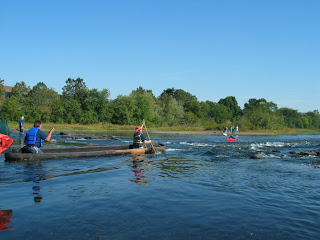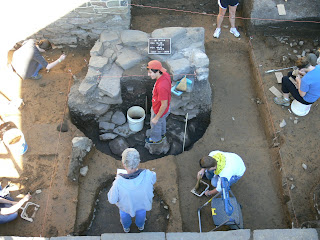We took a break from excavations at Fort Hunter last weekend to take our dugout canoe to a public venue at Gifford Pinchot State Park, in York County. We were invited to participate in an event sponsored by The Wooden Canoe Heritage Association, Ltd.. This is a non-profit membership organization devoted to preserving, studying, building, restoring and using wood canoes, and to disseminating information about canoeing heritage throughout the world. There are over 1800 members in this association and the event was well attended from folks all over the northeastern U.S. If you ever have an opportunity to attend one of their meetings, you should. These canoes are incredible and the canoeists are very knowledgeable and skilled.


Five years ago as part of our public outreach for Archaeology Month in Pennsylvania the Pennsylvania Historical & Museum Commission, Section for Historic Preservation, took on the task of making a dugout canoe. The method of construction was based on dugout canoes found in Pennsylvania and from early historic accounts of Native peoples producing these dugouts. A dugout canoe is simply a hollowed out log used as a watercraft. Dugouts have been found preserved in lakes and bogs all along the eastern seaboard and into Ohio. The oldest of these dugouts dates to more than six thousand years ago(BP). In Pennsylvania seventeen dugouts have been documented in bogs and lakes, mainly in the Poconos of northeastern Pennsylvania.
 Dugout canoe on exhibit at The State Museum found in Mud Pond, Luzerne County, Pennsylvania.
Dugout canoe on exhibit at The State Museum found in Mud Pond, Luzerne County, Pennsylvania.Our dugout was made from an Eastern White Pine log donated by Michaux State Forest through the Department of Conservation and Natural Resources(DCNR). The process of burning the log with a controlled fire and then scraping and chopping the wood was completed with the use of replica stone tools. Archaeologists find stone tools and have many theories as to their use; this was an opportunity to test these theories and compare the edge wear on these tools.
 Stone tools, adzes, celts and axe which were used in making the dugout canoe.
Stone tools, adzes, celts and axe which were used in making the dugout canoe.We have been sharing this dugout with the public at various venues including the Pennsylvania State Farm Show, Harrisburg’s Kipona Festival and recently to Cabella’s at Hamburg, PA. It has been subjected to all kinds of temperature and humidity and has stood the test of time quite well. A question that is repeatedly asked of us is “ Does it float?” . We tell our visitors Yes! On October 2nd, 2005 it traveled from Fort Hunter to City Island.
 Picture of the maiden voyage October 2005
Picture of the maiden voyage October 2005And yes, that was the only time we've put it in the water until October 9th of 2010. Almost five years to the date the dugout was launched on Pinchot Lake.
The dugout did well and the enthusiasm was contagious. Kurt Carr delivered a lecture and power point on the dugout process and shared the stone tools used to create the dugout with attendees. Everyone wanted to either make their own dugout or at least ride in ours. Now when folks ask us if it floats, we can be confident that yes- it floats!
 October 9th, 2010 on Gifford Pinchot Lake
October 9th, 2010 on Gifford Pinchot LakeToday is our last day at Fort Hunter Park. We will have lots to write about next week and some more interesting observations on the well. Thanks to all of our regular visitors and the many volunteers who have helped us with excavations. Now the shift is to the lab and cataloging and inventorying the collection. In closing here are a few shots of our progress this week.
 View of well with about 3 feet of soil removed, note clear view of construction trench around perimeter.
View of well with about 3 feet of soil removed, note clear view of construction trench around perimeter. View after removal of 5 feet of soil from well surround, students from Franklin & Marshall College helping us with excavations on October 13th.
View after removal of 5 feet of soil from well surround, students from Franklin & Marshall College helping us with excavations on October 13th.For more information, visit PAarchaeology.state.pa.us or the Hall of Anthropology and Archaeology at The State Museum of Pennsylvania .
No comments:
Post a Comment